Syria, Bahrain (and Beyond) Live Coverage: Two More Anniversaries
 Friday, February 17, 2012 at 9:48 |
Friday, February 17, 2012 at 9:48 |  Scott Lucas in
Scott Lucas in  Africa,
Africa,  EA Global,
EA Global,  EA Middle East and Turkey,
EA Middle East and Turkey,  Middle East and Iran
Middle East and Iran Protest in Benghazi, Libya, 17 February 2011
See also Syria Audio Special: A Resident of Homs Speaks to EA Worldview
2123 GMT: Perhaps the Bahraini police did not know that two prominent Western activists heading a peaceful protest towards Lulu Square would be a well-documented event --- but if they read EA, they would have guessed. Here are just a few of the pictures, which complement the videos that we posted below. We'll be following up on this story very soon.
A woman in Qadam challenges police with a peace sign, before the teargas and arrests.
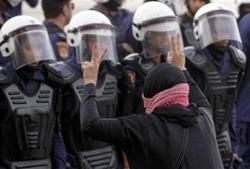
Flash grenades (sound bombs) are thrown at these women, at close range.
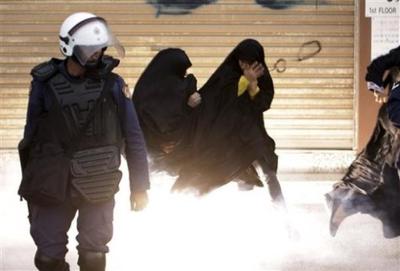
Medea Benjamin, after she was arrested.
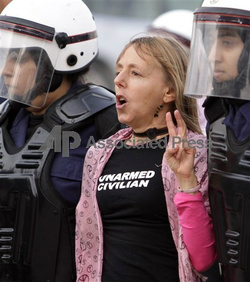
2104 GMT: The latest LCCS death toll in Syria has risen to 58, "among them three children and 12 soldiers who were publicly executed in Daraa. 16 martyrs fell in Daraa (Jassem, Hara), 17 fell in Homs, 6 fell in Mazzeh in Damascus, 5 martyrs fell in Deir Ezzor, 5 fell in Aleppo, and 3 in each of Hama, Idlib and 4 martyrs in Damascus Suburbs (Yabroud, Artouz, Douma)."
Despite the violence, several neighborhoods had protests earlier today, and this evening. Below, we have video of a daytime protest in Bab Sbaa, and an evening demonstration in the El Waer district, a dangerous activity in a city under siege:
2002 GMT: The US Ambassador to Syria, Robert Ford, has released a scathing condemnation of the recent arrests of prominent Syrian activists in Damascus:
Syria's government says it wants a political dialogue with the opposition. So do its few remaining friends among the international community. But if they want a real dialogue with the opposition, why does the Syrian government arrest people like human rights activist Mazen Darwish, who are calling for their basic human rights as espoused in Syria’s current constitution but not, in fact, respected by this Syrian government?
Despite the signature by Syrian Vice Foreign Minister on the Arab League Protocol last November that it would stop its arrest campaign and release political prisoners, Mazen Darwish, blogger Razan Ghazzawi, and twelve others were just arrested. The international community knows Darwish to be a strong defender of finding political solutions, rather than using violence, to solve Syria's crisis. Eleven months ago today, Syrian police arrested Darwish during a peaceful protest in solidarity with prisoners of conscience. This was one of the first protests of the revolution; it was a silent vigil that did not call for regime change, for violence, for anything other than the rights of political prisoners. Regime forces attacked the protesters. Darwish was beaten and arrested in a crowded Damascus square. Now we see that almost one year later, the Asad regime is doing the same thing, to the same people. While this is a testament to the resilience of the Syrian people, it is also a sober reminder that nothing has changed in Syria.
Ford goes on to say that other prominent activists were arrested this week, including a Christian and an Alawite.
1942 GMT: Bahraini authorities have released all female political prisoners (12 women) except one. Prominent activist Zainab Alkhawaja, whose father is also imprisoned, is scheduled to be detained "indefinitely".
1622 1922 GMT: Bahrain - Earlier we reported the arrest, and pending deportation, of Elaine Masons and Medea Benjamin. Well, an EA correspondent in Bahrain sends us this video, described below:
Video of the women's march that was lead by Elaine after it got attacked by mercenaries. Second 13 shows how the shooting was from close range, and the women suffocated and some were trapped between the car and a wall.
1914 GMT: The Syrian Uprising 2011 Information Centre shares this video:
The video shows the town of Hayt in Daraa province, close to the border with Jordan where there were reports of a massacre by Assad's forces 2 days ago. They are taking part in the Friday of Popular Resistance.
1902 GMT: There have also been protests in the Saudi Arabian town of Qatif, a town with a majority Shia population that has been the site of unrest, and a violent crackdown, in the last few months:
1809 GMT: Today's death toll continues to climb. According to the Local Coordinating Committees of Syria, 56 have been killed today, "among them 2 children and 12 soldiers who were publicly executed in Daraa. 16 martyrs fell in Daraa (Jassem, Hara), 15 fell in Homs (All of them from Baba Amro neighborhood), 6 fell in Mazzeh in Damascus, 5 martyrs fell in Deir Ezzor, 5 fell in Aleppo, and 3 in each of Hama, Idlib and Damascus Suburbs (Yabroud, Artouz, Douma)."
1748 GMT: CNN's Arwa Damon reports on the situation in Baba Amr, Homs:
Meanwhile, the activist in this video is very glad that it is raining in Homs so that he can collect the water, because Baba Amr has had no water for many days. The good news? Rain is expected for the next three days.
1734 GMT: According to many sources, chaos has broken out in Bahrain. Activist Sayed Mohamed shares several videos of today's events. This video, taken within the hour, reportedly shows "videos of protesters trying to head back to lulu square now being attacked."
Another video, taken before the attack, shows the protesters on the way to Lulu Square (Martr Square, adjacent to the former location of the Pearl Monument):
<
Activist Sayed Mohamed Almuhafda also shares this graphic picture reportedly showing "a young man was shot n his eye w a Rubber Bullet by mercenaries when he was peacefully protesting."
1724 GMT: James Miller has interviewed a resident of Homs (see the full article here)who describes a worsening humanitarian crisis and a new wave of shelling. The gunfire seemed to Sammy like a secondary concern, as the city is running out of food, medicine, and essential supplies (like milk and/or formula for feeding babies).
This video was reportedly taken earlier in the Khalidiya district of Homs. Smoke can be seen rising as a protest continues:
And this video, with English subtitles, was reportedly taken in the Baba Amr district today:
Homs city, Syria: A tank belonging to the Syrian regime army shelling populated areas and buildings in the neighborhood of Baba Amr as part of the regime military crackdown on civilians to silence the peaceful uprising. This video was taped on the 17th of FEb 2012.
Activist Rami al Jarrah shares this video, originally posted by the Activist News Association (ANA), which purports to show "Dr. Mohammad in a field hospital in babaAmr of homs with a patient dying, as he appeals to the arab world for help, french journalists are present in the video." We regret that it is graphic in nature.
1644 GMT: This video was reportedly taken today in the Marjeh district of Aleppo, where protests have been taking place this afternoon:
1635 GMT: James Miller is back after interviewing a resident of Homs (coming soon).
According to the latest tally by the Local Coordinating Committees, 48 people have been killed today in Syria, "among them 12 soldiers who were publicly executed in Daraa. 16 martyrs fell in Daraa (Jassem, Hara), 7 fell in Homs, 6 fell in Mazzeh in Damascus, 5 martyrs fell in Deir Ezzor, 5 fell in Aleppo, and 3 in each of Hama, Idlib and Damascus Suburbs (Daraya, Douma)."
Breaking down these numbers, significant violence has broken out in Damascus, after Mezzeh saw second significant protest in as many days. Also, the violence in Deir Ez Zor and Aleppo is another sign of further escalation of the conflict away from the areas that we are used to earing about.
And then, of course, there are the deaths in Homs, a tragic trend that we've become all too accustomed to hearing.
1602 GMT: EA's John Horne reports on the situation in Bahrain.
Reports are surfacing that the two foreign activists who were arrested earlier --- Elaine Masons and Medea Benjamin --- have been deported and are due to fly out of the country at 10pm tonight. Elaine spoke to EA last night and we will shortly be publishing a feature on her visit to Bahrain.The following video shows the protest the two women were arrested at before police broke it up. Elaine is the woman at the front at the start of the video and Medea is the woman wearing a T-shirt saying "unarmed citizen":
1450 GMT: Yesterday, EA reported that there were very large protests in Mezzeh, Damascus, a central district of the capital city extremely close to the heart of power. We also reported that there were arrests and injuries.
Already today there are more reports of protests there. According to activist Alexander Page, this video was taken just a little while ago, and it shows protesters removing a man who was shot while protesting in the streets:
The Coalition of Free Damascenes for Peaceful Change also report that this large protest took place in Kafer Souseh, near the Al-Nazeer Mosque, within the hour:
And this protest reportedly took place in the Midan district, inside the Zein al-Abdeen mosque.
But there are even wider-spread reports of protests in Damascus, in the Al Hajar al Aswad district, the Yalda district, and several other areas across the capital.
I'll repeat what I said yesterday - the common saying thrown about by reporters and Syrian experts was that when there were large protests in Damascus and Aleppo the regime would fall. It's now time to put those words to the test, as Damascus is now seeing growing, sustained, and daily protests.
1345 GMT: The LCCS is reporting that 24 people have been killed already today in Syria, "including 12 defected soldiers executed on the field from Jassem town (Daraa), 4 in Homs, 3 in Deir Ezzor, 2 in Aleppo, 2 in Mezze (Damascus), and 1 in Damascus Suburbs." According to the LCCS, the 12 soldiers were tried in front of the hospital in Jassem.
1308 GMT: Journalist Andrew Hammond reports that Elaine, from Ireland, and Medea, from the US, have been arrested at the Women's March in Bahrain. He uploads this picture of the women leading the march before the arrests:
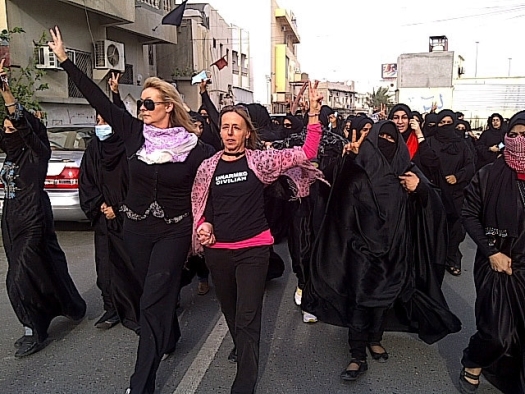
Asked by EA this morning why she was marching, Elaine said: "I'm marching to call for a stop to the kipnapping and the physical, sexual and emotional abuse of Bahrain children. See our 0940 update for more.
1255 GMT:. Bahrain. Journalist Naziha Saeed tweets that the Women's March at Quaddam Roundabout has been attacked by police:
Police used stun grenade on 11 women protesting next to #Qaddam roundabout #Bahrain
Activist Said Yousif uploaded the following pictures as the march was setting off:
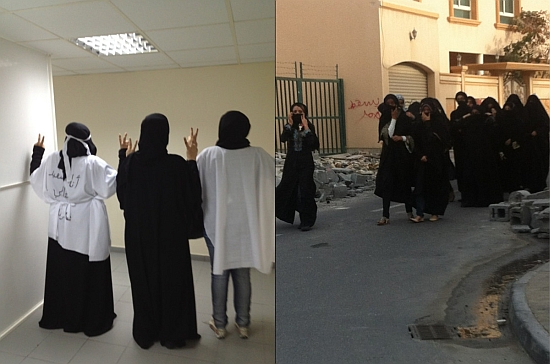
0940 GMT: In Bahrain, a women's march has been announced for 3 p.m., calling for an end to the abuse of children by security forces. The march will be led by Elaine Masons, an Irish woman who has been in Bahrain all week, and an American activist who has been part of a wider group of US observers.
Masons travelled independently to Bahrain on Saturday to live with villagers. Tweeting as "@bahraintrip2012", she said she was shocked and appauled by what she has seen and heard. "The real story is in the villages," she commented, noting the the daily tear gassing, the routine police incursions and abuses, the desparate need for basic medical supplies, and the total state of fear and persecution felt by many living outside the capital Manama.
Masons never intended to lead a march. However, the abuses she has witnessed and testimonies she has heard led her wanting to do something to raise the world's awareness of daily Bahraini life.
Masons said she has heard countless stories of crimes against young citizens which have gone unpublished and in many cases unreported, even to the Bahrain Centre for Human Rights. Yesterday, she met with a teenage boy who had been kidnapped by plainclothes security forces, slashed on the chest with a razor, and sexually abused. Despite the likely consequence of deportation, she wanted to join with women across Bahrain in calling for an end to such horrific treatment of minors.
0805 GMT: Summarising Thursday's diplomatic news on Syria....
The United Nations General Assembly passed a resolution, calling for an immediate halt to the Syrian regime's crackdown, by a 137-12 vote with 17 abstentions.
China and Russia, which vetoed a Security Council resolution last week that would have put legal force behind the demand for President Assad to transfer power, were among the No votes on the resolution which condemned "widespread and systematic violations of human rights".
The General Assembly's measure, unlike that of the Security Council, is non-binding.
0750 GMT: Anthony Shadid, the esteemed foreign correspondent of The New York Times, has died in eastern Syria, apparently of an asthma attack.
For more than two decades, Shadid offered distinguished coverage, notable for its portrayal of the human side of the story amidst conflict in the Middle East, for The Washington Post, The Boston Globe, and The Associated Press as well as The Times.
0620 GMT: We enter another Protest Friday by noting two one-year anniversaries.
In Libya, people began celebrating last night for today's commemoration of the start of the uprising against against Qaddafi regime. Although there had been ripples of dissent --- a protest over housing in Benghazi earlier in the month would have spiralling consequences --- 17 February 2011 was the formal start of the challenge that would topple the Libyan leader in the autumn.
Journalist Andy Carvin tweeted last night, "Benghazi now the world's happiest parking lot: absolute traffic jam with cars honking for joy, punctuated with occasional AK-47 fire."
In Bahrain, a different type of remembrance --- a year ago, three days after the start of the challenge to the Alkhalifa regime, security forces overran the main protest camp at Pearl Roundabout, killing several people. The demonstrators would regroup, but Pearl Roundabout would eventually be cleared --- and its iconic monument destroyed --- in the spring.
This is how we summarised the day:
Opposition in Libya had called a "Day of Rage" for Thursday, but even before they could take to the streets, that rage was being claimed by a regime in a different country.
The surprise attack by Bahrain's police upon the opposition camp at the Pearl Roundabout in the capital of Manama killed at least four people, but even that death toll does not begin to capture the violence of the day. As the monarchy moved the Army in force into Manama, its security services prevented treatment the hundreds of wounded, to the point of inflicting a savage beating on a prominent doctor. Journalists were blocked at Manama's airport, leaving those who were already in the country --- Nicholas Kristof of The New York Times was especially prominent in reporting via social media as well as reporting for his newspaper --- to try and get out an account that took in the scope of the brutality.
The regime's attack, which succeeded in breaking up an opposition at the roundabout that threatened to become a symbolic centre for demands for sweeping change, was not completely unchallenged. Doctors and nurses at Salmaniyieh Hospital staged a dramatic protest. Two junior ministers resigned, and at one point the Minister of Health was reported to have quit. The main opposition party Al Wafaq suspended its participation in Parliament and put out a statement calling for an enqury into the attack.
At this point, however, the protesters are fragmented, if not broken completely. The Bahraini regime has gone much farther than its Tunisian and Egyptian counterparts in an organised assault against a building opposition movement --- whether it can turn this into long-term success is the open question.
Then it was Libya's turn to occupy attention. This was not an easy effort --- unlike Bahrain, there were no foreign journalists in the country, leaving it up to social media to get out some reports --- but by evening, it was clear that there had been both a significant challenge to the Qaddafi regime and a heavy-handed attempt to crush the display of dissent.
At least 24 people are reported to have killed, but the protesters have succeeded in getting out the images of their defiance, to the point of the symbolic destruction of Muammar Qaddafi's Green Book that is supposed to guide the Libyan people. While the most significant protests were in Libya's 2nd and 3rd-largest cities, Benghazi and Al Bayda, there were demonstrations in at least three other cities during the day. And, by last night, there was at least one gathering --- captured and spread by video --- in the capital of Tripoli.
 Anthony Shadid,
Anthony Shadid,  Bahrain,
Bahrain,  Elaine Masons,
Elaine Masons,  Libya,
Libya,  Syria
Syria 
Reader Comments